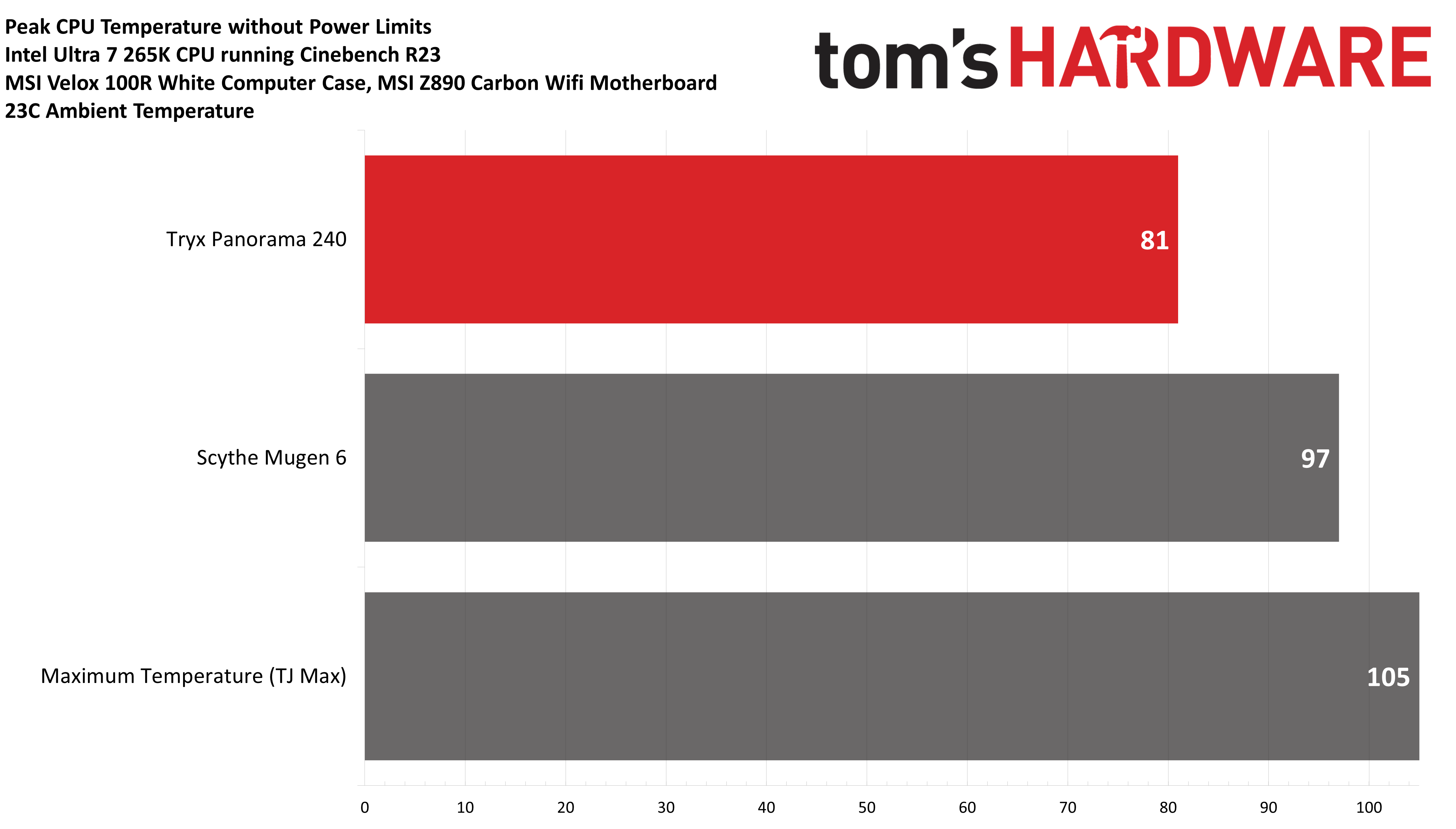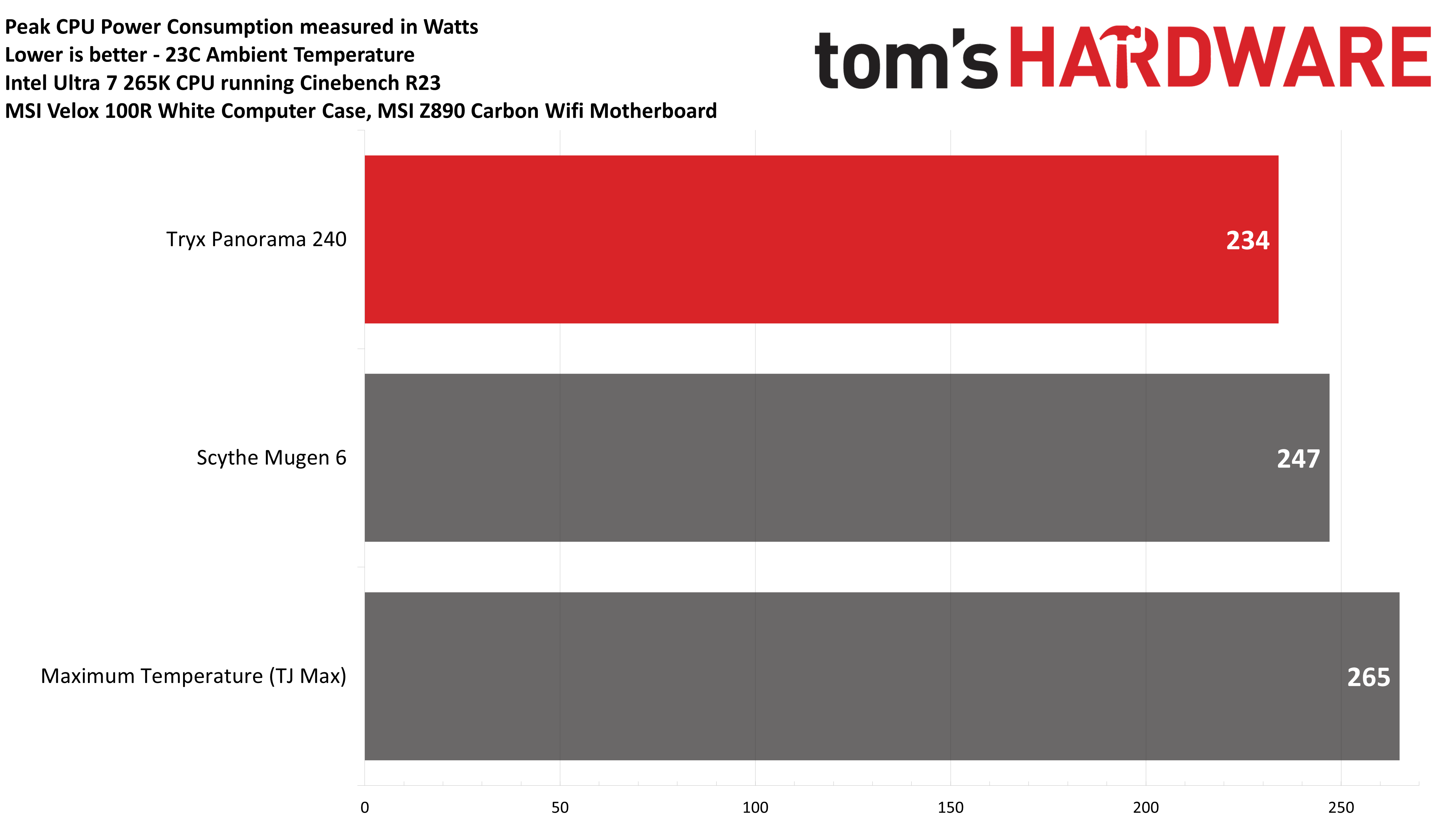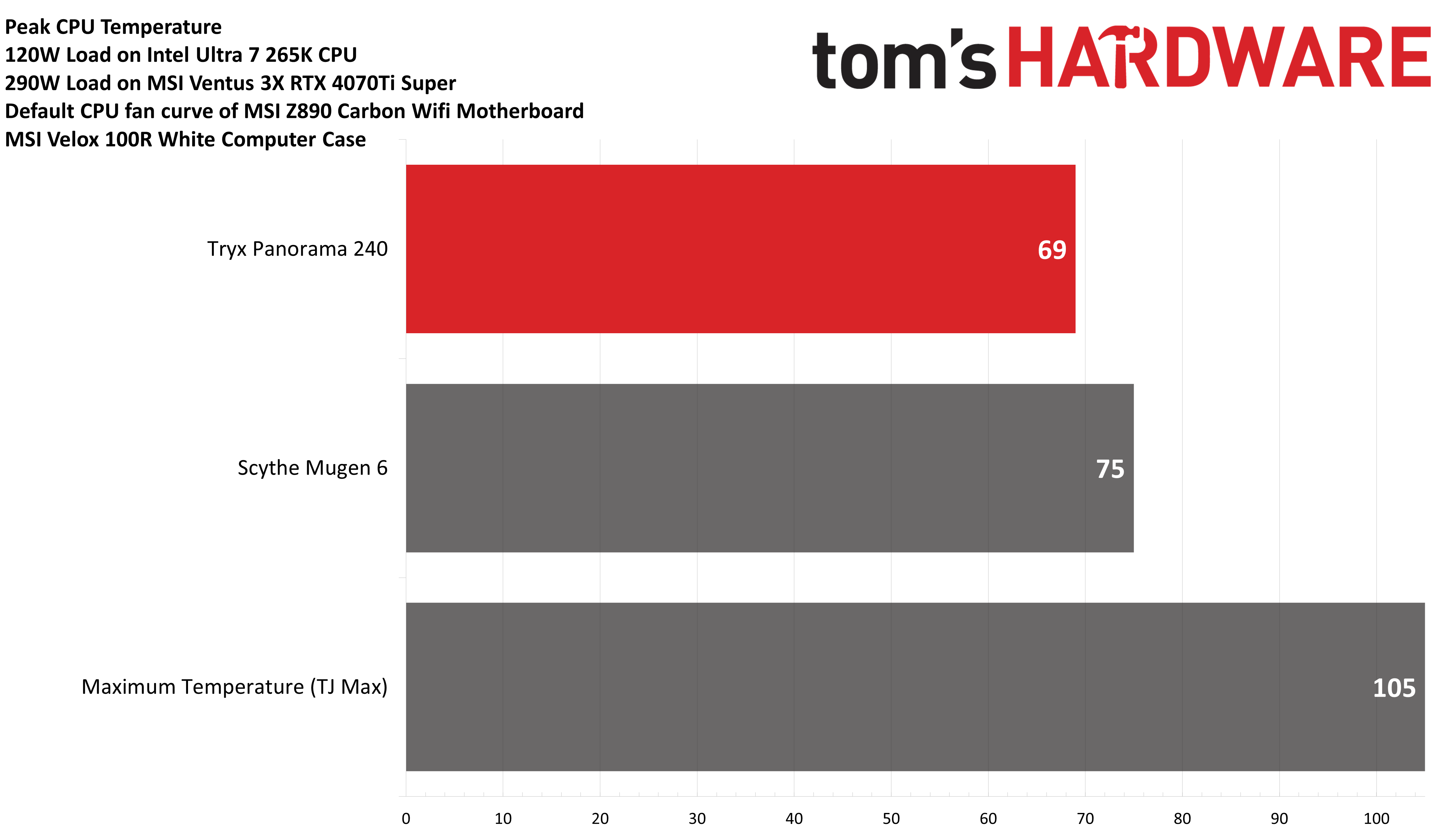Testing the impact of liquid cooling on Intel’s Core Ultra 7 265K using the Tryx Panorama 240
Liquid cooling Intel’s latest Ultra 7 can result in significant thermal improvements of up to 16C and reduce peak CPU power consumption by up to 15% due to reduced electrical leakage.
The advantages of Liquid Cooling Intel’s Core Ultra 7 265K
*️⃣ Noise normalized testing
What I can tell you is that with Arrow Lake CPUs, temperatures rise 2-3C when fans are run at a whisper-quiet 35 dBA in comparison to when you run them at full speeds. This variance seems to be the same, no matter what cooler is used. I’ve tested this with both Intel’s Core Ultra 7 265K and Core Ultra 9 285K.
I attempted to run noise-normalized benchmarks with the Tryx Panorama AIO, but the high minimum noise levels of the Tryx Panorama AIO prevented this sort of testing from being completed.
*️⃣ Peak CPU Temperature
The biggest advantage for liquid cooling the CPU, of course, is the reduction in peak temperature! Tryx Panorama enabled the CPU’s peak temperature to drop a whopping 16 degrees Celsius compared to an air cooler, which gives a comfortable thermal headroom margin for those interested in overclocking. Keep in mind the unit tested is only a smaller 240mm model - a 360mm AIO would very likely run a couple of degrees cooler.

*️⃣ Increased Power Consumption Efficiency
You might think that the only way a cooler impacts a CPU is with its temperature, but there’s actually more to it than that. Reduced temperatures translates into reduced electrical leakage, which in turn results in lower power consumption. How much of a reduction in power consumption will depend on the device being cooled. It’s easier to demonstrate this advantage with a GPU.
When using Tryx Panorama 240 AIO paired with Intel’s Core Ultra 7 265K, I observed a peak power consumption reduction of up to 15% compared to when the CPU runs at its peak temperature of 105C, dropping from 265W down to 234W.
Get Tom's Hardware's best news and in-depth reviews, straight to your inbox.
That said, the reduction in power consumption is smaller when compared to a good air cooler that can also keep the CPU under its peak temperature. Scythe’s Mugen 6 had a peak power consumption of around 247W when paired with Intel’s Core Ultra 7 265K, only about 6% higher than the Tryx AIO. It’s important to point out once more that the AIO being tested for this review is a smaller 240mm model; if I were to test with a stronger 360mm AIO the improvements here would be stronger.

120W CPU + 290W GPU results
I also wanted to see how a liquid cooler might show its advantage in gaming. In most games, the Core Ultra 7 265K will use less than 85W – but in the worst scenarios, it can peak around 120W. So for this test, I set the CPU’s power consumption to 120W and ran a full load on an RTX 4070Ti Super GPU.

The thermal gap wasn’t quite as large in this scenario. Instead of a whopping 16C, the difference between air cooling and liquid cooling was reduced to 6C – but that’s still a fairly significant gap.
Conclusion
Liquid Cooling Intel’s Core Ultra 7 265K can provide significant thermal headroom for overclocking. With Tryx Panorama 240 AIO, we observed up to a 16C reduction in temperature over air cooling. Additionally, compared to a CPU running at its maximum temperature of 105C (TJ Max), we observed a 15% reduction in CPU power consumption.
For most users, I’d recommend a standard air cooler for Intel’s Core Ultra 7 265K. However, those looking for the best energy efficiency, lowest temperatures, and / or overclocking headroom would be wise to spend a little more on a good liquid cooler instead.

Albert Thomas is a contributor for Tom’s Hardware, primarily covering CPU cooling reviews.
-
bgunner I think it would be interesting to see the advantages of water cooling on the AMD 9800X3D in regard's to power consumption also. I'd be a nice comparison between AMD and Intel's offerings.Reply
It's interesting that dropping the temps lowers it power consumption. This means that the higher the temp the more resistance is in the circuit. This leads me to wonder what else on the board can be cooled more to gain extra efficiency. Being a gamer efficiency isn't my top priority but good knowledge to have while in a overclocking session. -
thestryker I opted for a Peerless Assassin 140 for mine because it was just under $40 and I'm waiting to see if LGA 1851 is a one and done or not. The cooler does seem to be very good on the 265K like was shown on LGA 1700. I didn't bother with a contact frame this time as the board I'm. using has the RL-ILM and again waiting to see whether or not one and done for 1851.Reply
I do need to remount it because I forgot I'd given a friend my MX-5 to use and it hadn't been returned yet so I used what came with the cooler just to get it done. -
YSCCC Reply
Fwiw the TR coolers usually comes with their TF7 paste which actually is a very good paste in itself, not really worth repasting with mx5 IMOthestryker said:I opted for a Peerless Assassin 140 for mine because it was just under $40 and I'm waiting to see if LGA 1851 is a one and done or not. The cooler does seem to be very good on the 265K like was shown on LGA 1700. I didn't bother with a contact frame this time as the board I'm. using has the RL-ILM and again waiting to see whether or not one and done for 1851.
I do need to remount it because I forgot I'd given a friend my MX-5 to use and it hadn't been returned yet so I used what came with the cooler just to get it done. -
USAFRet I'll be putting a Thermalright Frozen Prism 360 on an Ultra 7 265k in a couple of weeks.Reply -
thestryker Reply
If I'd actually applied it well I wouldn't worry about it at all, but I very much didn't due to its consistency and not having my spreader either.YSCCC said:Fwiw the TR coolers usually comes with their TF7 paste which actually is a very good paste in itself, not really worth repasting with mx5 IMO -
YSCCC Reply
ic, I have tried it when I switched the Noctua U12A to a dirt cheap TR 360 AIO for trial a while ago, I just use the noctua 5 dot method with the size recommended by noctua, the TF7 basically performs within 2C spikes in the uncontrolled environment I tried it with the NT-H2 paste, I did that because I used the final NT-H2 for initial installation, then ended up managed to free up just enough space in the HDD bay for me to mount the 360 in the Fractal North with tubes down direction without bending the tubes, and at the time the NT-H2 is used up and I got the TF7 beside so try it, 99% of the time they perform exactly the same and no apparent consistency issue with the 5 dot method.thestryker said:If I'd actually applied it well I wouldn't worry about it at all, but I very much didn't due to its consistency and not having my spreader either.
What I noticed though is the initial run the temp was slightly higher on the TF7 and it sets as soon as the first CB R23 run for temp difference trial, so I believe at heat it spreads well enough itself and no need to care too much for repasting and wasting -
thestryker Reply
The TF7 that came with my cooler was very sticky and didn't really want to separate (very stringy) so I couldn't put it down in dots or even lines. I did get some more spreaders so I could reapply that if I wanted to now. Also have some MX-6 and Heilos pads I could use so it's just a matter of making up my mind and actually doing it. Temps are fine except for heavy load and haven't really been doing much there.YSCCC said:ic, I have tried it when I switched the Noctua U12A to a dirt cheap TR 360 AIO for trial a while ago, I just use the noctua 5 dot method with the size recommended by noctua -
YSCCC Reply
nice, if I were you I won't even bother, and since I forgot, maybe bare die K6 era? IME spreading it manually usually creates more air pockets casuing weird hotspot more than just use a pea dot and later in larger IHS, X pattern or 5 dots and let the mounting pressure do the jobthestryker said:The TF7 that came with my cooler was very sticky and didn't really want to separate (very stringy) so I could put it down in dots or even lines. I did get some more spreaders so I could reapply that if I wanted to now. Also have some MX-6 and Heilos pads I could use so it's just a matter of making up my mind and actually doing it. Temps are fine except for heavy load and haven't really been doing much there. -
thestryker Reply
I got in the habit after redoing a few video card cooler mountings where it made a measurable difference. I haven't noticed any issues on the two CPUs I did it with other than less excess paste. That sort of issue might depend on the consistency of the paste being used along with quantity.YSCCC said:if I were you I won't even bother, and since I forgot, maybe bare die K6 era? IME spreading it manually usually creates more air pockets casuing weird hotspot more than just use a pea dot and later in larger IHS, X pattern or 5 dots and let the mounting pressure do the job -
YSCCC Reply
right, IME it is more about the viscosity of the paste especially at high heat load, some paste like the Gelid extreme will be too watery when hot so every few months to half a year you will need repaste and notice massive difference, but if it's something like the Noctua paste or TR TF7 which is very thick, they normally hold up pretty well even after like 3 years of daily use, that's when I tend to stick to Noctua paste, and the TR is just happen to be included with the contact frame and the AIO where I kept one as sparethestryker said:I got in the habit after redoing a few video card cooler mountings where it made a measurable difference. I haven't noticed any issues on the two CPUs I did it with other than less excess paste. That sort of issue might depend on the consistency of the paste being used along with quantity.